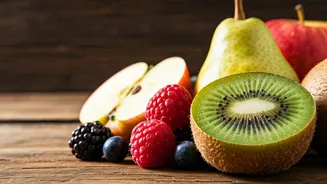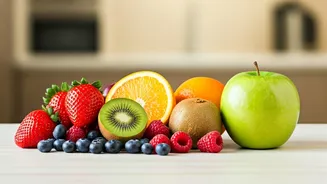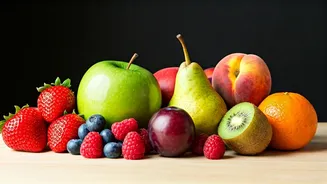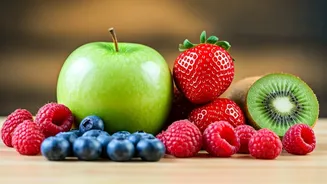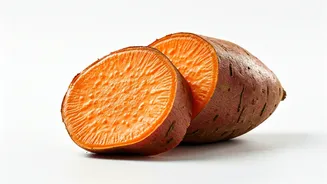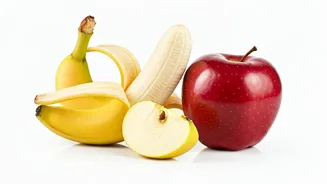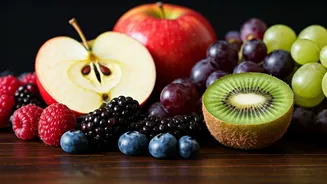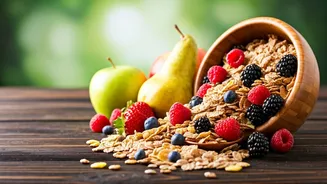Berry Bonanza
Berries often top the list of diabetes-friendly fruits. Strawberries, blueberries, raspberries, and blackberries are packed with antioxidants, fiber, and vitamins,
while being low in sugar. Fiber helps slow down sugar absorption, preventing rapid spikes in blood glucose levels. Aim for about one cup of berries per serving to enjoy their benefits without significantly impacting blood sugar. Berries are versatile: enjoy them on their own, add them to yogurt, or blend them into a smoothie for a refreshing treat. They provide a delightful combination of flavor and nutrition, making them an excellent choice for individuals managing diabetes.
The Apple Advantage
Apples are a readily available and satisfying fruit option, but it's important to choose the right kind and portion size. A medium-sized apple can be part of a diabetic diet, especially if eaten with the skin on. The skin adds fiber, helping to slow down sugar absorption. Apples contain various vitamins and minerals, contributing to overall health. It is wise to consider the glycemic index (GI) and glycemic load (GL) of an apple, keeping in mind that some varieties may affect blood sugar more than others. Eating an apple with a source of protein or healthy fat, such as a handful of almonds, can further help manage the impact on blood sugar levels. A medium apple can be a balanced snack that can be a healthy option.
Citrus Delights
Citrus fruits, like oranges, grapefruits, and tangerines, offer a refreshing burst of flavor and are a good choice for people with diabetes. They are rich in vitamin C and fiber, which aid in overall health. Fiber helps control blood sugar levels by slowing down the digestion and absorption of sugars. A medium orange or a small grapefruit can be a part of a diabetic meal plan, but portion control is essential. Consider the GI and GL of each fruit, and consume them in moderation. Citrus fruits are great as snacks or additions to salads. They have a good nutritional profile, which is beneficial for people monitoring their sugar intake, and can add a bright, tasty note to the diet.
Stone Fruit Choices
Peaches, plums, and cherries are part of the stone fruit family and can be included in a diabetes-friendly diet when eaten mindfully. These fruits provide vitamins, minerals, and fiber, adding to their nutritional value. A small to medium peach or a handful of cherries can be enjoyed as a snack. Be mindful of their sugar content, and pair them with a protein source, like a few nuts or a small serving of Greek yogurt, to minimize any blood sugar impact. Choosing fresh, seasonal stone fruits is often the best approach. Because it is simple to be conscious about the quantity consumed, it makes it easier to keep within recommended carbohydrate levels.
Kiwi’s Kick
Kiwis are a nutritional powerhouse that can fit into a diabetic meal plan. They have a good amount of fiber and offer vitamins C and K. Kiwis also have a moderate glycemic index, making them a suitable choice in moderation. The fiber in kiwi helps slow down the release of sugar into the bloodstream. One medium kiwi is a suitable serving. Kiwis are great eaten on their own or added to smoothies or salads. Their vibrant flavor and nutrient content make them a healthy and enjoyable option.
Pear Pleasures
Pears can be included in a diabetes-friendly diet, with a focus on portion control. Pears offer fiber, vitamins, and minerals. Fiber slows down sugar absorption, which can help regulate blood sugar levels. Opt for pears with the skin on to maximize fiber intake. Choose fresh pears over canned pears in syrup. A small to medium pear is a reasonable serving. Pears can be eaten as a snack or included in meals. Their balanced nutrition profile makes them a reasonable option.
The Avocado Twist
While technically a fruit, avocados stand out due to their low sugar and high-fat content. They are a good option for diabetics looking for a healthy fat source. Avocados are rich in monounsaturated fats, which are beneficial for heart health. They also provide fiber, which aids in blood sugar control. Portion control is essential with avocados due to their high-calorie content. A quarter to half an avocado can be a part of a meal. Adding avocado to salads or using it as a spread is a great way to enjoy its flavor and benefits. Their inclusion in a diet can provide nutritional variety and healthy fats.
